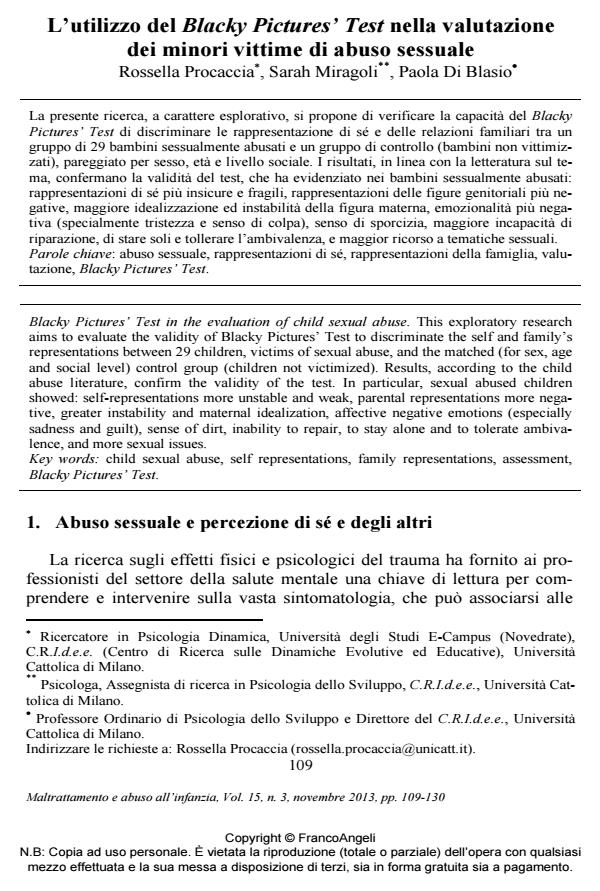L’utilizzo del Blacky Pictures’ Test nella valutazione dei minori vittime di abuso sessuale
Titolo Rivista MALTRATTAMENTO E ABUSO ALL’INFANZIA
Autori/Curatori Rossella Procaccia, Sarah Miragoli, Paola Di Blasio
Anno di pubblicazione 2013 Fascicolo 2013/3
Lingua Italiano Numero pagine 22 P. 109-130 Dimensione file 713 KB
DOI 10.3280/MAL2013-003006
Il DOI è il codice a barre della proprietà intellettuale: per saperne di più
clicca qui
Qui sotto puoi vedere in anteprima la prima pagina di questo articolo.
Se questo articolo ti interessa, lo puoi acquistare (e scaricare in formato pdf) seguendo le facili indicazioni per acquistare il download credit. Acquista Download Credits per scaricare questo Articolo in formato PDF

FrancoAngeli è membro della Publishers International Linking Association, Inc (PILA)associazione indipendente e non profit per facilitare (attraverso i servizi tecnologici implementati da CrossRef.org) l’accesso degli studiosi ai contenuti digitali nelle pubblicazioni professionali e scientifiche
La presente ricerca, a carattere esplorativo, si propone di verificare la capacità del Blacky Pictures’ Test di discriminare le rappresentazione di sé e delle relazioni familiari tra un gruppo di 29 bambini sessualmente abusati e un gruppo di controllo (bambini non vittimizzati), pareggiato per sesso, età e livello sociale. I risultati, in linea con la letteratura sul tema, confermano la validità del test, che ha evidenziato nei bambini sessualmente abusati: rappresentazioni di sé più insicure e fragili, rappresentazioni delle figure genitoriali più negative, maggiore idealizzazione ed instabilità della figura materna, emozionalità più negativa (specialmente tristezza e senso di colpa), senso di sporcizia, maggiore incapacità di riparazione, di stare soli e tollerare l’ambivalenza, e maggior ricorso a tematiche sessuali.
Parole chiave:Abuso sessuale, rappresentazioni di sé, rappresentazioni della famiglia, valutazione, Blacky Pictures’ Test.
- I precursori della violenza infantile nel periodo perinatale: una review della letteratura Stefania Cataudella, Giulio Cesare Zavattini, in MALTRATTAMENTO E ABUSO ALL'INFANZIA 2/2015 pp.11
DOI: 10.3280/MAL2015-002002 - Processi di resilienza in minori vittime di violenza: un progetto di intervento con adolescenti in Lituania Francesca Giordano, Chiara Ferrari, in MALTRATTAMENTO E ABUSO ALL'INFANZIA 2/2018 pp.105
DOI: 10.3280/MAL2018-002007 - La valutazione del minore nelle perizie in ipotesi di abuso sessuale Paolo Capri, in MALTRATTAMENTO E ABUSO ALL'INFANZIA 2/2016 pp.13
DOI: 10.3280/MAL2016-002002 - My Body: il disegno della figura umana a dimensione naturale nel trattamento delle vittime di violenza Annalisa Di Luca, in MALTRATTAMENTO E ABUSO ALL'INFANZIA 2/2014 pp.97
DOI: 10.3280/MAL2014-002006 - Il concetto di sé e degli altri nei bambini vittime di violenza cronica: il ruolo dell'età e del PTSD Rossella Procaccia, Guido Veronese, Marco Castiglioni, in MALTRATTAMENTO E ABUSO ALL'INFANZIA 2/2014 pp.57
DOI: 10.3280/MAL2014-002004 - Child Sexual Behaviors in School Context: Age and Gender Differences Sarah Miragoli, Elena Camisasca, Paola Di Blasio, in Journal of Child Sexual Abuse /2017 pp.213
DOI: 10.1080/10538712.2017.1280866 - Children in Conflictual Separations: Representations of Self and Family through the Blacky Pictures’ Test Rossella Procaccia, Sarah Miragoli, Elena Camisasca, Paola Di Blasio, in Journal of Forensic Psychology Research and Practice /2020 pp.185
DOI: 10.1080/24732850.2020.1714404 - Eventi traumatici e attaccamento nel Disturbo Bipolare Mitia Rendiniello, Elena Ierardi, Maria Giulia Olivari, Gloriana Rangone, in MALTRATTAMENTO E ABUSO ALL'INFANZIA 3/2017 pp.143
DOI: 10.3280/MAL2016-003007 - Linee guida e protocolli per l'intervista del minore sessualmente abusato: una rassegna Claudia Scolari, in MALTRATTAMENTO E ABUSO ALL'INFANZIA 2/2016 pp.31
DOI: 10.3280/MAL2016-002003 - Child Abuse Potential Inventory: sviluppo di una versione breve Sarah Miragoli, Daniela Traficante, Elena Camisasca, Paola Di Blasio, in MALTRATTAMENTO E ABUSO ALL'INFANZIA 3/2017 pp.69
DOI: 10.3280/MAL2017-003005 - Psicopatologia, esperienze traumatiche e attaccamento nella prostituzione adolescenziale Chiara Petrocchi, Mario D'Aguanno, Patrizia Velotti, Giulio Cesare Zavattini, in MALTRATTAMENTO E ABUSO ALL'INFANZIA 3/2017 pp.31
DOI: 10.3280/MAL2016-003003 - L'ascolto del minore vittima di violenza tra esigenze cliniche e giuridiche Rossella Procaccia, in MALTRATTAMENTO E ABUSO ALL'INFANZIA 2/2016 pp.7
DOI: 10.3280/MAL2016-002001 - Trauma e sviluppo psichico: analisi di un caso di abuso sessuale Mirella Montemurro, in MALTRATTAMENTO E ABUSO ALL'INFANZIA 1/2018 pp.81
DOI: 10.3280/MAL2018-001006
Rossella Procaccia, Sarah Miragoli, Paola Di Blasio, L’utilizzo del Blacky Pictures’ Test nella valutazione dei minori vittime di abuso sessuale in "MALTRATTAMENTO E ABUSO ALL’INFANZIA" 3/2013, pp 109-130, DOI: 10.3280/MAL2013-003006